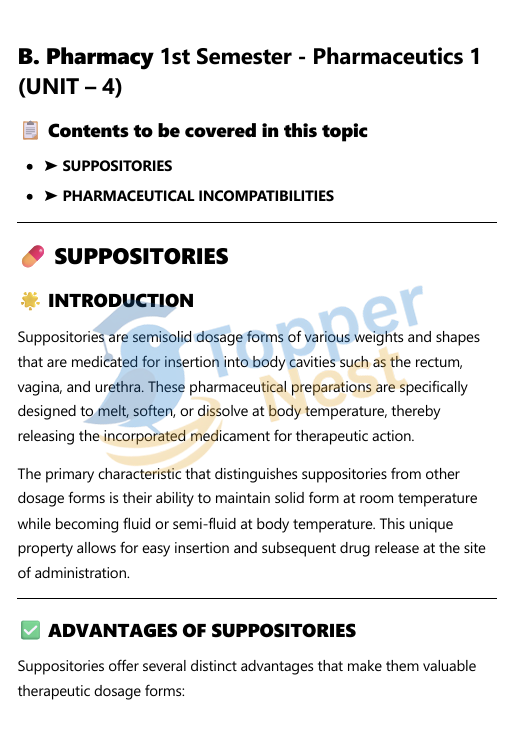This unit covers two important areas of pharmaceutics: suppositories, a type of solid dosage form, and pharmaceutical incompatibilities, which are crucial in ensuring safety and efficacy in drug formulation and dispensing.

What is Suppositories?
A suppository is a solid dosage form designed to be inserted into a body orifice (most commonly the rectum, vagina, or urethra), where it melts, softens, or dissolves at body temperature. Once the suppository releases the active drug, the medication is absorbed into the bloodstream or acts locally at the site of administration.
Why Use Suppositories?
Suppositories are used as an alternative route of administration when other methods, like oral medication, are not suitable. Common reasons include:
- Difficulty Swallowing: For infants, the elderly, or patients who are unconscious or unable to swallow pills or liquids.
- Nausea and Vomiting: If a patient is experiencing severe nausea or vomiting, a suppository can be used to bypass the stomach and prevent the medication from being expelled.
- Rapid Local Effect: Suppositories can deliver medication directly to the affected area for a local effect, such as treating hemorrhoids, constipation, or vaginal infections.
- Systemic Absorption: The rectum has a rich blood supply, allowing drugs to be absorbed systemically into the bloodstream. This can be advantageous for several reasons:
- Bypassing First-Pass Metabolism: Rectal administration can partially bypass the liver’s first-pass metabolism, which can increase the bioavailability of certain drugs that would otherwise be broken down too quickly.
- Avoiding Gastric Irritation: For drugs that are irritating to the stomach lining, suppositories provide an alternative route.
Types of Suppositories
Suppositories are classified primarily by their intended route of administration:
- Rectal Suppositories
- Vaginal Suppositories (Pessaries)
- Urethral Suppositories
What is Pharmaceutical incompatibilities?
Pharmaceutical incompatibilities refer to undesirable interactions between two or more substances that are combined in a prescription or a drug formulation. These interactions lead to a change in the physical, chemical, or therapeutic properties of the final product, potentially affecting its stability, efficacy, safety, or appearance.
Incompatibilities can occur during various stages, including compounding, manufacturing, dispensing, storage, and even at the time of administration (e.g., mixing two drugs in an IV line). It is the pharmacist’s responsibility to identify and correct these issues.
Incompatibilities are broadly classified into three main types:
1. Physical Incompatibilities
These are interactions that result in a physical change to the dosage form, which is often visible to the naked eye. The therapeutic activity of the drug may not be immediately lost, but the physical change can make it difficult to administer or lead to an inaccurate dose.
2. Chemical Incompatibilities
These interactions involve a chemical reaction between the components, leading to the formation of new, often undesirable, compounds. The result can be a loss of drug potency, the creation of a toxic substance, or a change in color, odor, or gas formation.
3. Therapeutic Incompatibilities
These are interactions that alter the pharmacological effect of the medication. This type of incompatibility is not always visible but can have a profound impact on the patient’s treatment outcome. It typically arises from errors in prescribing.
FAQs – Suppositories & Incompatibilities
1. Why are suppositories used instead of oral dosage forms in some patients?
Suppositories are ideal when oral administration is not feasible—such as in vomiting, unconscious, or pediatric patients.
2. What is the importance of displacement value in suppository preparation?
Displacement value helps in accurately calculating the amount of base required when a drug is added, ensuring uniform dosage.
3. How can pharmaceutical incompatibilities be avoided?
- Proper storage conditions
- Thorough compatibility checks during formulation
- Consulting pharmaceutical references or pharmacists before mixing drugs
4. What happens if a physical incompatibility is not corrected in a formulation?
It may lead to product separation, poor appearance, and uneven dosing, compromising both safety and patient compliance.
